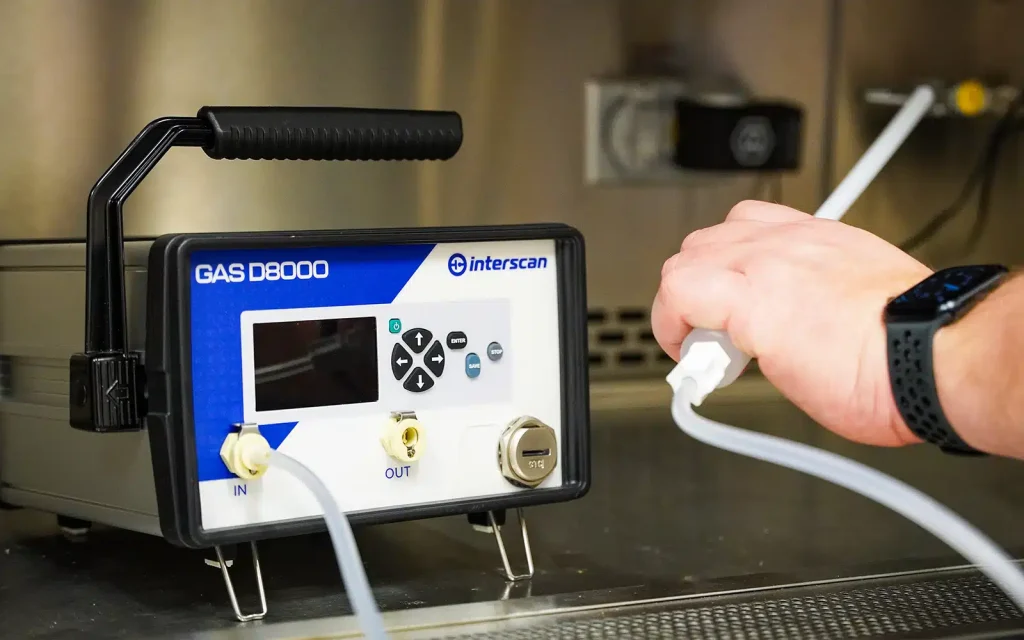“Estimating exposure to toxic gaseous emissions in workplaces is one of the first steps in human hazard assessment. Risk assessment depends on determining levels of pollutants of interest as part of continuous or spot monitoring of the atmosphere.”
- Active and passive air sampling are methods of collecting gaseous pollutants for analysis to determine risk.
- Both methods are equally accurate. The choice depends on the substance to be estimated and available resources.
- Active air sampling requires a pump for sample collection, while passive sampling uses natural diffusion.
- Active air sampling requires more components and is more expensive than passive sampling, but it can be used for all gaseous pollutants.
Estimating exposure to toxic gaseous emissions in workplaces is one of the first steps in
human hazard assessment. Risk assessment depends on determining levels of pollutants of interest as part of continuous or spot monitoring of the atmosphere. Sampling air is part of the gas analysis procedure. In this article, you can learn more about two means of sampling- active and passive methods- and where each technique is suitable.
Air Sampling
Some considerations in choosing air sampling methods for gas detection are the pollutant of interest, sample type, and duration.
Two categories of pollutants exist- particulate matter and gases/vapor.
Gases and vapors: These pollutants spread everywhere as they are gaseous. Gases are not liquid at standard temperature and pressure (STP) and can be pollutants such as ozone, nitrous oxide, carbon monoxide, etc. Vapors are formed due to the evaporation of compounds that can also exist as liquids at STP. Vapors can co-exist as gas and aerosols when there is condensation, as in toluene and benzene.
Particulate matter: These pollutants can be solids or liquids suspended in air. Particulate matter (PM) can be coarse with particle size up to 10 micrometers or fine PM, which is 2.5 micrometers and below. PM examples are dust, smoke, fibers, and fumes. The concentration and particle size are crucial data necessary for PM estimation.
Based on air sampling methods, gas monitoring devices can be active or passive. Laboratory and field studies show no difference in accuracy between the two air sampling methods.
The difference lies in the mode of collection and the pollutants they are used for sampling.
Choosing the correct testing methods is vital for getting accurate results. The following comparison of active and passive air sampling will show safety managers which method is relevant.
Passive Air Sampling
Passive air sampling is used for gases and vapors and long-term testing. It is also called diffusion sampling, as the method relies on the kinetic energy of molecules and natural diffusion and doesn’t involve air pumping for sample collection. Passive sampling is not helpful for aerosols and particulate matter, as they don’t follow the diffusion principles of gases and vapors.
In passive sampling, air is allowed to pass into the device. The natural motion of gas molecules helps them collide with the sorbent in the passive sampler. Each pollutant has a specific diffusion coefficient. Combining this data with exposure time allows you to estimate the time-averaged sample concentration. However, face velocity and environmental factors like temperature and high humidity will also influence the sampling rate.
Design and Components
A wide variety of passive air samplers exists, but the essential components remain the same:
- A diffusive surface where the gases and vapors enter.
- A sorbent medium that collects the gas and vapor molecules.
Typical passive air samplers are tube, badge, or radial types. The samplers have a different diffusion path and surface area, which produces distinct device uptake rates.
- Tubes have a small opening and long diffusion path and offer the lowest uptake rates.
- Radial provided the highest uptake rate as they have porous cylinders.
- Badges with different uptake rates intermediate to the other two types are available even from a single manufacturer.
Passive sampling is simple and doesn’t require electricity. The gases are also protected during transport and storage.
Advantages and Disadvantages of Passive Air Sampling
Some advantages and disadvantages of passive air sampling are discussed below.
- Advantages: Passive sampling requires less equipment and is cost-effective. Therefore, it is a practical solution for air monitoring. Setting up the equipment and using it requires hardly any expertise, and neither does the testing, making the entire process convenient.
- Disadvantages: Passive sampling is applicable only for gases and vapors and not PM and aerosols. In the US, only two diffuse samplers, for toluene and nitrogen dioxide, are validated by the National Institute for Occupational Safety and Health (NIOSH) and an additional one for styrene by the Occupational Safety and Health Administration (OSHA). However, manufacturers have validated methods.
The uptake rate can depend on the device and cannot be altered. A high uptake rate can cause overloading at more concentrations. In comparison, a low uptake rate can’t collect adequate amounts of samples.
Active air sampling can be used instead of passive sampling. However, there are several significant differences.
Active Air Sampling
Active sampling uses a pump to pass air into the sample container, unlike passive sampling, which relies only on gas diffusion. Therefore, this method is suitable for gases and vapors collected by a sorbent medium and for collecting particulate matter and aerosol with size-selective samplers.
Moreover, wind speed, humidity, and temperature changes do not influence the gas concentrations collected.
Another difference between passive and active samplers is that the latter’s flow rate can be changed by setting it and verifying it with a calibrator. The flow rate can be milliliters per minute for gases/vapors; for particulate matter and aerosols, the flow rate is measured in liters per minute.

Figure 1: Interscan’s GasD® 8000 portable gas analyzers use active sampling with the
Wand, which can be attached to the sensor with a clip-in system.
Design and Components of Active Air Samplers
The essential components of active air samplers are a pump, container, and collection media. Several active air samplers exist and depend on the substances being sampled.
For gases and vapors: Use sorbent tubes containing collection media such as silica gel, tenex, or activated charcoal. Annular denuders with collection media coated on the walls can also be used; these samplers use a pump and natural diffusion.
For PM and aerosols: You can choose from several active air sampling devices, usually involving preloaded air sampling cassettes. Size-selective sampling is possible for PM10 or PM2.5 by physically separating particles according to size through cascade and virtual impactors.
Some manufacturers offer additional components to improve active air sampling. Interscan’s gas detectors AccuSafe for continuous monitoring and GasD® 8000 portable gas analyzers use active sampling. Interscan offers a Sampling Wand that optimizes spot checks using the portable GasD® 8000. The Wand can be attached to the Interscan sensor with a clip-in system to probe otherwise inaccessible areas.
Interscan’s Sampling Wand is made of materials resistant to corrosion and chemical reactions to ensure it does not interfere with the gas sample’s integrity. It can be used with active sampling systems that use a pump to draw in the air with the pollutants, as the Wand needs active air movement to transport the sample gas from the probe tip to the sensor. The Wand cannot be used for passive sampling devices, which lack active air collection through pumps.
The advantages of the Interscan Sampling Wand are as follows:
- Provides an extended reach: The Wand can reach confined or remote areas where leaks might occur but are not easily accessible by personnel, such as tight spaces behind industrial machinery, within ventilation ducts, or beneath floor panels.
- Increases safety: Using a sampling wand, technicians can detect harmful gases from a safe distance, reducing the risk of exposure to toxic or explosive gases.
- Ensures precise gas estimations: Sampling wands can be directed precisely to suspected leak points, which allows for more accurate and localized gas detection, reducing the time and effort spent in identifying the source of a leak.
- Versatile in function: These wands can be used in various environments, from industrial settings to outdoor areas, where detecting gas leaks quickly and efficiently is crucial.
Advantages and Disadvantages of Active Air Sampling
Some of the main advantages and disadvantages of active sampling are as follows:
Advantages: The flow rate can be controlled as the pump has a variable speed, allowing personnel to collect the required samples over optimal times. The number of government-validated active samplers on the market is significant in contrast to passive samplers, providing industries with a range of safe choices.
Disadvantages: Though active air sampling is the standard method used, it does have some disadvantages compared to passive sampling for gases and vapors. The active samplers are bulky and more difficult to carry. Active samplers require uptake rate setting and require personnel expertise. Moreover, the instruments are more expensive due to additional components.
Despite a few disadvantages, active air sampling is a worthwhile investment if sample numbers are high.
Duration of Sampling
Besides the type of sampling, another crucial aspect of gas detection is the sampling duration. Safety managers must consider factors such as pollutant source and feasibility while fixing sampling duration. To optimize resource and time use, shorter total durations within 24 hours can be used when the emission rate and concentration do not fluctuate. In a typical industrial plant where the emissions will vary depending on operation timings, a longer total duration per day will be necessary to capture all variations within 24 hours.
In the case of sampling, to ensure staff safety and health, more is better!
Written by:
 Vijayalaxmi Kinhal
Vijayalaxmi Kinhal
Science Writer, CID Bio-Science
Ph.D. Ecology and Environmental Science, B.Sc Agriculture
Sources
Boston University School of Public Health. (2016, Jan 13). Exposure Assessment. Introduction to Basic Concepts. Retrieved from https://sphweb.bumc.bu.edu/otlt/mph-modules/exposureassessment/exposureassessment8.html
EPA. (2023, July 11). Particulate Matter (PM) Basics. Retrieved from https://www.epa.gov/pm-pollution/particulate-matter-pm-basics
Hatice Pekmez. (2017). Cereal Storage Techniques: A Review. Journal of Agricultural Science and Technology B, 6(2), 1–6. https://doi.org/10.17265/2161-6264/2016.02.001
Zabiegała, B., Kot-Wasik, A., Urbanowicz, M., & Namieśnik, J. (2010). Passive sampling as a tool for obtaining reliable analytical information in environmental quality monitoring. Analytical and Bioanalytical Chemistry, 396(1), 273–296. https://doi.org/10.1007/s00216-009-3244-4


